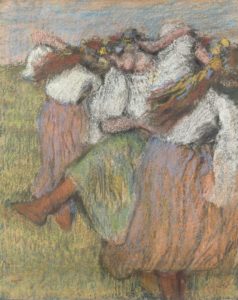SETTING THE RECORD STRAIGHT ABOUT “RUSSIAN” ARTApril 8, 2022 Ever since Russia’s invasion of Ukraine on February 24th, many institutions have sought to further scrutinize their relationship with all things Russian. London’s National Gallery is one of the most recent organizations to do just that, even if it was in a small gesture: they righted a century-old wrong by correcting the name of a drawing by Edgar Degas from Russian Dancers to Ukrainian Dancers. The Russian Empire, and the Soviet Union that followed it, were enormous landmasses, constituting about one-sixth of all land on Earth at any given time. And while it’s easy to label anything from those two now-dead world powers as simply “Russian”, it’s important to remember their diversity. Whether under czarism or communism, only around half of the population was actually Russian. Everyone else self-identified with one of the many, smaller ethnic groups, like Armenians, Georgians, Belarussians, and, of course, Ukrainians. Ukrainians were always the largest ethnic minority in the Empire and the USSR, making up anywhere between fifteen and twenty percent of the total population depending on the year. But because everything in the Empire and the USSR was frequently grouped into a single, Russian monolith, Ukrainian culture was, and still is, often either confused for Russian culture or grouped with Russian culture. This is done both intentionally (by Russians) and accidentally (by non-Russians). The latter of the two is likely what happened when Edgar Degas executed his 1899 pastel-on-paper work Russian Dancers. The debate about whether to rename the work from Russian Dancers to Ukrainian Dancers precedes the Russian invasion. For several years, scholars and activists have pointed out that it was likely a Ukrainian folk dance group that Degas observed in Paris. The clearest piece of evidence in support of the name change is the ribbons in the dancers’ hair being blue and gold. If you’ve been living under a rock for six weeks, those are the national colors of Ukraine, which have their origins in the medieval period but have been used as a symbol of the Ukrainian people since 1848. Some have claimed that the continued use of the term “Russian” in the title is just one example of Russia’s continued appropriation of, and hegemony over, all Slavic cultures, as well as everyone else’s disinterest in the issue. The term “laziness” has understandably been thrown around. According to statements from the National Gallery, the current Russian war in Ukraine has allowed them to officially change the name of the piece due to a greater sense of awareness of Ukrainian culture and identity. Ever since the National Gallery made its announcement on Monday, many people have flocked to social media, either to applaud or criticize the decision. It appears that many of the critics do not understand the context surrounding this decision. Many seem to have just read the headlines and thought this is some sort of political stunt, or perhaps the museum leadership is jumping on the political correctness bandwagon. Some claim that it’s okay to refer to the subjects as Russian, since Ukraine didn’t exist as a country when Degas completed the work. Well, see my comments above. Lack of statehood does not negate the existence of culture and identity. It’s easy for Russian people to say this sort of stuff because it’s Russian political and cultural leaders who advocate a sort of pan-Slavism that invalidates a lot of non-Russian Slavic culture. It’s the same thing that happens when Irish people get confused for Brits. Or Canadians get confused for Americans. Or Austrians for Germans. Or New Zealanders for Australians. I could go on and on. But it’s this sort of thinking that instills a sort of collective humiliation and fatigue, to never being recognized as a culture in your own right. One Twitter user was trying to be clever when she claimed, “You cannot just change the title of a painting just to cancel out Russians because of the war. It’s like changing Da Vinci‘s Mona Lisa and naming it Karen. Idiots.” What that Twitter user seems incapable of comprehending is that famous artworks have their names changed all the time, specifically to better reflect our understanding of a work. Ironically, she points out the Mona Lisa, because the Da Vinci portrait is not known by that name outside the English-speaking world. If you ask someone who speaks Italian or French, they will say that the Mona Lisa is called La Gioconda or La Joconde. Similarly, Diego Velázquez’s best-known work, Las Meninas, was not always known as such. Though painted in 1656, the royal family portrait was commonly referred to as The Family of Philip IV. It did not gain its current name until 1843 when the authors of an art catalogue referred to it as The Ladies-in-Waiting or Las Meninas. And it’s not just the Old Masters. One of Pablo Picasso’s most famous works is Les Demoiselles d’Avignon, showing a parade of young Catalan prostitutes. Picasso originally called the work Le Bordel d’Avignon or Le Bordel Philosophique. But it was André Salmon, an organizer for the Salon d’Altin, who gave the painting its current popular name when Picasso exhibited the work there in 1916. So, the National Gallery may be taking advantage of the war, but not for the reasons one may assume. Both New York’s Metropolitan Museum of Art and Houston’s Museum of Fine Arts have Degas works entitled Russian Dancers. Despite the announcement from the National Gallery, neither American institution has made any indication about a similar move. | MORE ARTICLES |


No comments:
Post a Comment